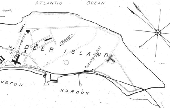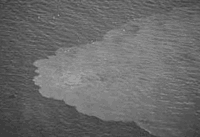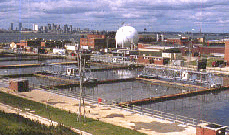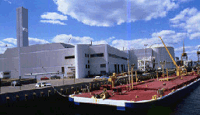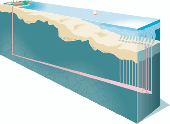| Home |
| Water System |
| Sewer System |
| Harbor and Bay |
| School Program |
| About MWRA |
| Doing Business with MWRA |
| Contact MWRA |
A History of the Sewer System
Massachusetts Water Resources Authority
|
Though Metropolitan Boston's sewer system was one of the best in the country 100 years ago, decades of neglect brought it to the brink of disaster in the early 1980s. A timeline of key historical events offers a rough sketch of the rise and fall of this important public health infrastructure.
State legislators approved the construction of the Boston Main Drainage System. The new system, built between 1877 and 1884, diverted sewage from 18 cities and town to Moon Island in Boston Harbor. There sewage was held for release with the outgoing tide.
1889 — First Regional Sewers
The Metropolitan Sewerage District (MSD) was formed to build one of the first regional sewerage systems in the country. Expansions to the sewerage system continued through the early 1900s. The system soon became recognized as one of the best in the country, though it provided no treatment. It merely collected the wastewater and sent it out into the harbor.
1919 — Water Quality Crises
Sewage pollution forced the closure of several harbor clam beds. The Metropolitan District Commission (MDC) assumed control of the MSD system. By 1933, due to worsening pollution, all shellfish taken from the harbor required purification. In 1940, planners recommended the construction of treatment plants at each of the harbor's three raw sewage discharge locations: Moon Island, Nut Island and Deer Island.
1952 — First Regional Sewage Treatment Plant
The Nut Island Primary Wastewater Treatment Plant (demolished in 1998) was completed. Sewage from the southern collection system received treatment for the first time.
1968 — Second Regional Sewage Treatment Plant
The Deer Island Primary Wastewater Treatment Plant was completed. Sewage from the northern collection system received treatment for the first time. Moon Island's discharge was put on emergency stand-by status.
1972 — New Federal Environmental Regulations
Federal and state laws mandated primary and secondary treatment for all municipal sewer systems, effectively taking the option for lesser treatment levels away from the states.
1985 — New Regional Water and Sewer Operator
The newly created MWRA assumed control of water and sewer systems from the MDC. Because the level of wastewater treatment inherited by the MWRA was below federal standards, a federal court order mandated the construction of a new treatment plant.
1989 — First Improvements to Regional Treatment Plants
Both Deer Island and Nut Island treatment plants halted discharge of more than 10,000 gallons per day of floatable pollution--grease, oil, and plastics--known as scum.
Sludge-to-Fertilizer Facility completed, allowing daily sludge discharges into Boston Harbor to end. 1995 — First Half of New Treatment Plant Complete
New primary treatment plant at Deer Island completed, increasing the system's overall capacity and the effectiveness of its treatment.
1997 — Secondary Treatment Added
First phase of Secondary Treatment Plant completed, increasing the level of solids removal for dry weather flows at Deer Island to 80% and allowing the plant to meet the requirements of the federal Clean Water Act for the first time.
1998 — Regional System Consolidated
MWRA opened the Inter-Island Tunnel connecting the South System flows to Deer Island, ending discharges from the Old Nut Island Plant. Start-up of the second battery of secondary treatment at DITP.
2000 — Outfall Tunnel and Plant Complete
Completion of the Outfall Tunnel allows MWRA to move effluent discharge from the confined waters of Boston Harbor to the deep waters of Massachusetts Bay. Completed construction of third and final battery of secondary treatment at DITP.

